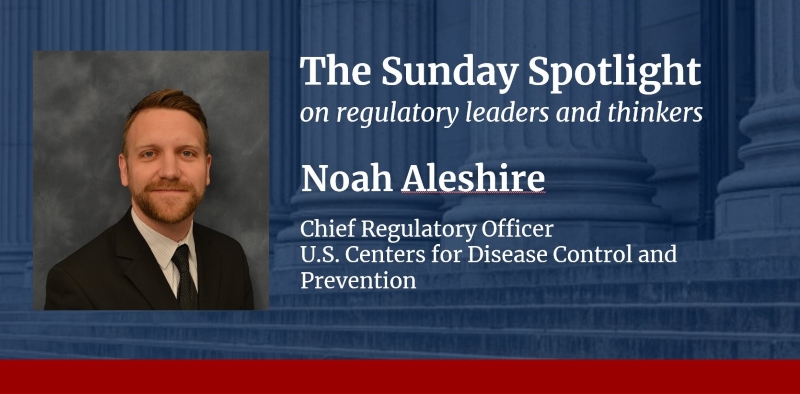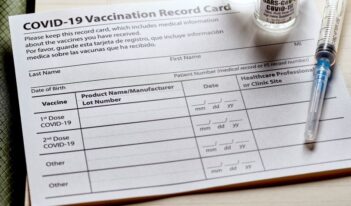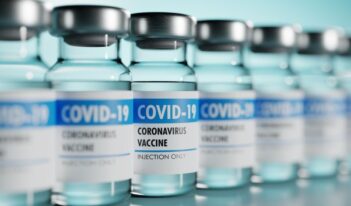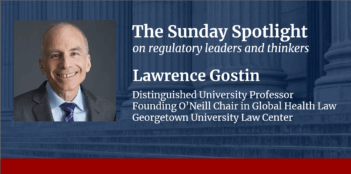
Noah Aleshire, chief regulatory officer at the CDC, discusses the value of a collaborative and informed regulatory process.
In a conversation with The Regulatory Review, Noah Aleshire, chief regulatory officer at the Centers for Disease Control and Prevention (CDC), shares his perspective on the CDC’s regulatory work with a focus on collaboration between agency branches, agencies themselves, and the public.
The CDC, a division of the Department of Health and Human Services, has created guidance in response to the COVID-19 pandemic over the last several years, and has recently drawn public attention for its rule on dog and cat importations into the United States.
According to Aleshire, the CDC’s regulations should be shaped by efforts to improve available public health data, recently exemplified in the agency’s data modernization initiative. Aleshire also speaks to the importance of interagency collaboration and the value of a regulatory process where agencies “lay their cards on the table.”
As the chief regulatory officer at the national public health agency, Aleshire works to develop the CDC’s rulemaking initiatives. Aleshire has been with the CDC for 14 years; previously, he worked as a policy analyst at the agency.
Aleshire graduated from the University of San Diego School of Law, where he was awarded the James D’Angelo Outstanding Child Advocate Award. He began his legal career as a Presidential Management fellow at the CDC.
The Regulatory Review is pleased to share the following interview with Noah Aleshire.
The Regulatory Review: What is your role at the CDC?
I’m the CDC’s chief regulatory officer and I lead the Regulatory Affairs Unit in the Office of the CDC’s Director. My team and I work with the regulatory programs across the agency to support their rulemaking—helping them develop effective rules, navigate the clearance and review process, and build the CDC’s regulatory strategy. Our office also handles the CDC’s review of interagency regulations, helping bring a public health lens to the rules issued by our sister agencies. The unit is relatively new and is one of the many organizational reforms CDC made after the COVID-19 public health emergency.
TRR: The CDC was extremely active in the public health response to COVID-19. It also recently published a rule regulating the entry of dogs and cats entering the United States. How would you describe the scope of the CDC’s rulemaking authority or agenda?
The CDC has several distinct regulatory authorities. We, along with USDA’s Animal .and Plant Health Inspection Service, jointly administer the Federal Select Agent Program, which regulates the possession, use, and transfer of biological agents—such as Ebola and anthrax—and toxins that could present a threat to the public. We have occupational safety regulations in our National Institute for Occupational Safety and Health, including the approval of respiratory protective devices like N-95s.
We also make rules to prevent the introduction and spread of communicable diseases into the United States, including quarantine rules, a range of rules issued during the COVID-19 emergency, and the dog importation rule you mentioned, which aims to reduce the risk of rabies being imported into the United States. The CDC also partners with the Centers for Medicare and Medicaid Services to jointly issue regulations related to laboratory requirements under the Clinical Laboratory Improvement Amendments of 1988.
Although these are diverse and varied areas of rulemaking, they are connected by a common thread: protecting people from, and mitigating the impact of, health and disease threats.
TRR: How is the work you do on regulatory development informed by public health data?
Everyone at the CDC is eventually told the story of John Snow—the 19th century physician who mapped the distribution of London’s cholera cases and traced them back to a single water pump. He convinced the local council to disable the pump, which ended the outbreak. It’s the quintessential example of data informing regulation. But it’s not just a question about how data informs regulation; it’s about how regulation can help get better data.
The CDC has advanced a major data modernization initiative to strengthen our national data infrastructure, and regulation has a key role to play. The CDC works closely with HHS Office of the National Coordinator for Health Information Technology to help build seamless connections between health care information technology and public health data systems. This collaboration is an example of how interagency relationships can encourage policies that yield better data for public health agencies and reduce burden on health care providers.
TRR: How does the work you and your colleagues do intersect with or involve collaboration with other parts of the Department of Health and Human Services (HHS) or other federal agencies in the regulatory process?
The CDC is America’s public health agency, but the health of the American people is an all-of-government effort, and countless agencies have health as part of their charge. A key early focus of the CDC’s Regulatory Affairs Unit is to strengthen these interagency relationships and provide effective, useful feedback and partnerships to these agencies. A core premise of good rulemaking is to break agencies out of their silos and echo chambers and get diverse inputs to make rules thoughtful and more effective. We hope that strong, long-term interagency relationships will make our rules and their rules more effective at addressing the diverse range of health threats facing the public.
TRR: What changes in the CDC’s approach to regulatory decision-making have taken place in recent years?
The key changes have not been just about regulations, but how the CDC thinks about policy generally. Public health guidance gets complex quickly, and in the wake of the COVID-19 emergency, the CDC made a concerted effort to strengthen our processes to ensure that we translate science effectively into practical, easy-to-understand policy. That charge has affected every part of our policy work and led directly to the establishment of the Regulatory Affairs Unit in the Office of the Director. Our unit serves as a hub for our regulatory work and strategy, trying to bring a big-picture perspective to our regulatory goals and provide partnership and support to our regulatory divisions across the CDC.
TRR: How does public trust affect the work of the CDC, and more specifically the regulatory work of the agency? What is the importance of public engagement with the regulatory process?
Since her first day here, the CDC Director Mandy Cohen has emphasized the need to prioritize the building and re-building of people’s trust in the CDC and public health institutions. In my time in this role, I’ve found that when we talk about the ways to develop trust, it can sound a lot like the things regulators do every day—engaging the public and external entities, spelling out policy arguments along with the costs and drawbacks of the agency’s approach, showing our data, thinking through alternatives, and acknowledging uncertainty. Most of what the CDC does is not regulatory, but I think we can learn a great deal about building strong, clear, evidence-based policy by looking at the regulatory process and how it gets agencies to lay their cards on the table and directly engage with the public.



